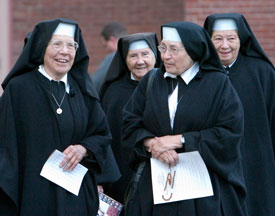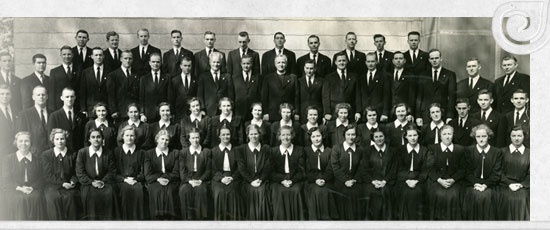Living a traditional religious life through total consecration to the
Immaculate Heart of Mary. Promoting the reign of Jesus Christ in all things.
 Our community, the Sisters of Saint Benedict Center, Slaves of the Immaculate Heart of Mary, has its origins in Cambridge, Massachusetts.
Our community, the Sisters of Saint Benedict Center, Slaves of the Immaculate Heart of Mary, has its origins in Cambridge, Massachusetts.
Just after the beginning of World War II, Catherine Goddard Clarke – later Sister Catherine – founded a student center called Saint Benedict Center in the shadow of Harvard University. Saint Benedict Center was a gathering place for Harvard and other college students interested in learning more about the truths of the Catholic Faith. Father Leonard Feeney, SJ became the leading light and spiritual father of the Center in 1944. He and other speakers drew crowds as they lectured and gave classes on everything from Dante to the saints, from Greek to Latin, and in particular, philosophy and theology. There was such enthusiasm for the Faith that many were baptized into it, others returned to the Church after long absences, and countless others renewed and deepened their faith. Several of the Center’s early members entered seminaries and convents.
In 1949, under the direction of Father Feeney and Catherine Clarke and concerned with the growing attacks on Catholic doctrine, many Center men and women organized into a religious community called the Slaves of the Immaculate Heart of Mary. The primary focus of the community was to preserve Catholic teaching, particularly the doctrine of the necessity of the Church for salvation. In the beginning, the Sisters and Brothers continued their studies and led an austere life founded on the three vows of poverty, chastity, and obedience and a fourth vow to defend the doctrines of the Church. To support their religious life they began to publish books on the Faith which they took all over the United States.
In 1958, the Slaves of the Immaculate Heart of Mary moved to their present location – Still River, Massachusetts – to embrace a more monastic lifestyle and adopt a modified Benedictine rule. The community continued to publish Catholic works and began farming, and the grade school begun in Cambridge was expanded to include high school grades. Differences in governing appeared in the community after Sister Catherine’s death, and ultimately most of the Brothers became Benedictine and most of the Sisters reorganized as the Sisters of Saint Benedict Center, Slaves of the Immaculate Heart of Mary. Eventually, four other communities of Slaves of the Immaculate Heart of Mary were formed — one each in New Hampshire, Ohio and California, and a second one in Massachusetts. All of these communities are committed to defending the Church’s doctrines and promoting the Faith through publishing and teaching.




